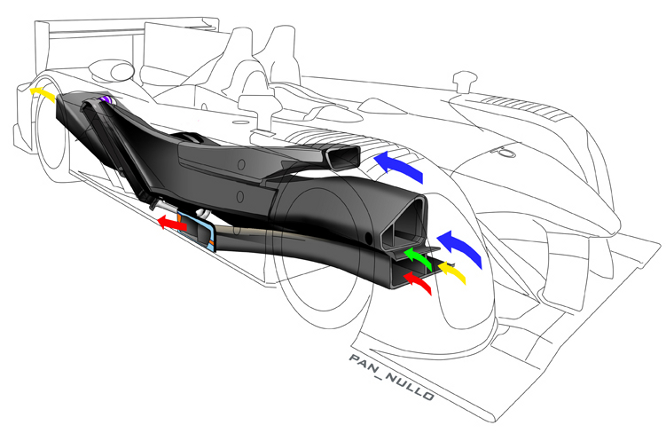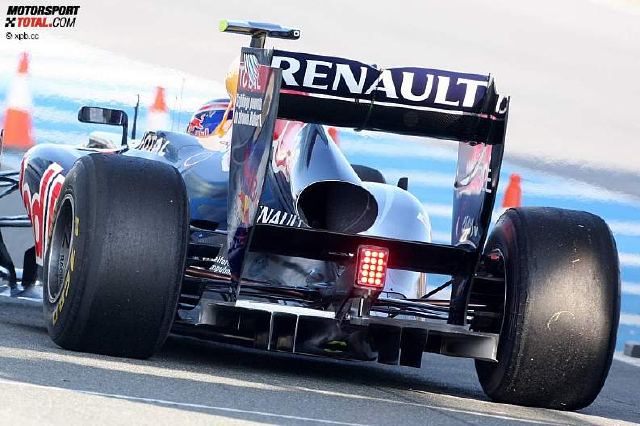animax wrote:@malcolm
Animax: Coanda effect? Seriously? How does that even fit into this discussion?
How does a flexible front wing have anything to do with pushing air around the tires? Because it flexes to perhaps two degrees from horizontal? Calculate the sine of two, and you'll see how close to zero the lateral effect would be.
Also, variations in the geometry of the third flap serve to change the effective chord profile of the wing. While that curved part may push the air over a tiny bit, again, it won't do much at all in terms of lateral air movement.
The angle of the image you posted is misleading. Look at these five images; there is no way you can claim that the upper element acts like some sort of giant scoop.
Are you kidding?

I'm sure that this paper from 2005
http://skrci.me/W9fKW will clarify F1 aerodynamics.Here is just a taste of it:
The Coanda effect is also utilised on a modern Formula 1 car with the purpose, not of generating downforce directly, but of guiding and conditioning airflow in one place, as a means of maximising downforce elsewhere....
First, good job and picking and choosing parts of my replies to comment on. What about the other paragraphs?
Second, good job at using a theory so basic that it doesn't actually apply to your arguments. All that you've done is referenced a theory that basically states that air stays attached to a body. It doesn't back up any of the varying arguments that seem to change from post to post, giving me headaches.
Given that, are we in agreement that flexible wings do not aid in pushing air around the outside of the tire? And we also agree that the curves seen in the upper flap of the RB7 does not act like a giant scoop but more like a regular wing?
Aside from that, if you want to have a discussion about F1 aerodynamics, stop talking about spoons and actually discuss, *in detail*, how you think effects work such as the Coanda effect, Kutta Condition, Kutta-Joukowski Theorem, Bernoulli Effect or even if you want to rock the Navier-Stokes Equation. Most of us here get this stuff (yeah, ok, I was a little mislead about the Coanda effect, but upon reading your article it just basically infers that flow will adhere to a curved body... it doesn't really relate to whatever you are arguing, which seems to change from post to post).
You can't just say "COANDA EFFECT" and then expect people to say "oh wow, you're right because you used big fancy words and name-dropped fancy theorems". You actually have to explain yourself.
Please try to be more clear. I used to suck at English-Literature class in school, until my teacher told me a technical way to write an essay: Point, Evidence, Explanation. If you use those three things correctly whenever you argue something, you can't lose. Please: make a point, use a bit of evidence (effects, theorems and equations, or even a quote), and then explain how that applies to your argument. It will make it easier for everyone to understand.
godlameroso wrote:1.)How would it speed up, it has to climb a curve and smack the driver's helmet, regardless I'm not talking about the nose, all the way to the front bulkhead, I'm talking about the tip of the nose. The nose cone tip, in the picture in the previous post you will see it's the yellow colored part, the rest of the nose is blue. Notice how the wing supports are placed under the drooping part of the nose cone. I'm positive this shape causes the tip of the nose to deflect a few mm this combined with the wing's deflection and I could see why people think the wing is illegal.
2.)

The yellow and red arrows are ducts, the green one is for the brakes and the blue one is for cooling. That's for an LMP car, I'm sure F1 cars have more effective ducting, and Red Bull probably has the most effective ducting for creating downforce. That's why Newey doesn't like KERS it interferes with the ducting inside the chassis. The RB7 has that huge hole in the back for a reason, and it's not to house small animals nor is it to just to expel hot air. Look at the back of the McLaren, the hole in the back is tiny, as is with almost all other cars. Red Bull are the only ones with that big an opening.
1) The same reason why air produces lift when it "climbs a curve" over an airplane wing. With subsonic flows, shapes like that sort of act like a nozzle, speeding up the flow. Most shapes like that will feel a greater effect from the air speeding up over the top rather than any effects of changing the direction of mass flow (you need a sharp corner and a steep incline for it to act like a NASCAR spoiler or the nose of a Riley & Scott MkIII). Notice how LMP louvres start before the top of the curve of the fenders? That means that the air has accelerated even though it is still moving upwards.
What you are doing with your hand out the window is replicating a NASCAR spoiler because of the angles you likely put your hand at, and the inability for your hand and fingers to keep the flow attached over them (they are far from a smooth body).
2) I have to ask you the same question... what are you even arguing?
The red arrows are ducts to allow the diffused air from the front diffuser to escape. The yellow arrows are ducts that allow air to pass through to minimize drag and perhaps enhance the diffuser by blowing air over it. Again, it doesn't directly produce downforce, it just aids other devices in producing downforce.
Beyond that, the RB7 is designed to minimize the effect of dirty air going over the diffuser and beam wing. Instead of just letting that dirty, confused turbulent air coming out of the sidepods and radiators ruin the effects of those devices, Newey channeled it up to exit between the beam wing and the main wing, where it would have little effect on downforce. He was not creating downforce by channeling that flow up, but allowing other aerodynamic devices to be more efficient by redirecting that dirty flow so that those other devices could get clean, laminar flow to them.

See where it is aimed? It will exit the hole and go over the beam wing (if it was designed to enhance the beam wing as some sort of blown apparatus, the hole would be aiming for under the wing). It is close to the beam wing so that it doesn't dirty the air going under the upper, main wing.
Sorry, but you are wrong: that hole is actually just there to expel hot air; however, it aims to expel it into a region where it will have the lowest consequences on the aerodynamic devices around it.
More info:
http://scarbsf1.wordpress.com/2011/02/1 ... d-cooling/ The yellow and red arrows are ducts, the green one is for the brakes and the blue one is for cooling. That's for an LMP car, I'm sure F1 cars have more effective ducting, and Red Bull probably has the most effective ducting for creating downforce. That's why Newey doesn't like KERS it interferes with the ducting inside the chassis. The RB7 has that huge hole in the back for a reason, and it's not to house small animals nor is it to just to expel hot air. Look at the back of the McLaren, the hole in the back is tiny, as is with almost all other cars. Red Bull are the only ones with that big an opening.
The yellow and red arrows are ducts, the green one is for the brakes and the blue one is for cooling. That's for an LMP car, I'm sure F1 cars have more effective ducting, and Red Bull probably has the most effective ducting for creating downforce. That's why Newey doesn't like KERS it interferes with the ducting inside the chassis. The RB7 has that huge hole in the back for a reason, and it's not to house small animals nor is it to just to expel hot air. Look at the back of the McLaren, the hole in the back is tiny, as is with almost all other cars. Red Bull are the only ones with that big an opening.

I'm sure that this paper from 2005 http://skrci.me/W9fKW will clarify F1 aerodynamics.Here is just a taste of it:
The Coanda effect is also utilised on a modern Formula 1 car with the purpose, not of generating downforce directly, but of guiding and conditioning airflow in one place, as a means of maximising downforce elsewhere....The yellow and red arrows are ducts, the green one is for the brakes and the blue one is for cooling. That's for an LMP car, I'm sure F1 cars have more effective ducting, and Red Bull probably has the most effective ducting for creating downforce. That's why Newey doesn't like KERS it interferes with the ducting inside the chassis. The RB7 has that huge hole in the back for a reason, and it's not to house small animals nor is it to just to expel hot air. Look at the back of the McLaren, the hole in the back is tiny, as is with almost all other cars. Red Bull are the only ones with that big an opening.
